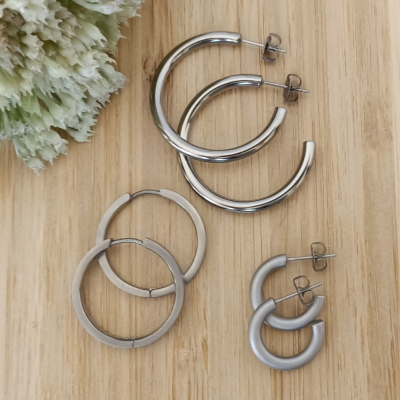

With so many brands claiming to have the right earrings for sensitive ears it’s hard to know where to start. We hope to take the guesswork out of choosing earrings for sensitive ears by sharing our top tips.
The #1 Tip for choosing earrings for sensitive ears

Always choose earrings that are nickel-free. Nickel is one of the most common contact allergens in the world and a leading cause of irritation in healed piercings. Despite the high incidence of nickel allergy, nickel is regularly used in jewellery because it is a low cost and easy to work with. Nickel can be found in jewelry at all price points from costume jewelry through to expensive gold products.
Pro Tip – Nickel allergies can develop over time after repeated or prolonged exposure to earrings which contain nickel. So if earrings you’ve worn comfortably for a while start causing you irritation then nickel allergy may well be the culprit.
Choose Materials Carefully
The easiest way to steer clear of nickel and other potentially irritating materials is to choose earrings made from the safest materials. We recommend –
- Titanium. Titanium is available in a variety of different grades and not all jewellery labelled ‘titanium’ is the same. Most titanium jewellery on the market is made from alloyed titanium, meaning the titanium has been mixed with other metals which may contain irritants. We use only commercially pure titanium in our earrings, which is the safest choice.
- Niobium.
- Medical Plastic.
- Platinum.
- Gold. While 24ct (pure gold) would be a very safe option for sensitive ears it is rarely made into jewelry because of its softness. Almost any gold jewelry you buy will be a mixture of gold and other metals. For example 18 carat gold would be 18 parts gold to 10 parts other metals (75% pure gold). So if you have sensitive ears or allergies check with your jeweller about what constitutes the remaining metals.
Check Earring Post/Wire thickness
The standard post width for traditional ear lobe piercings is 20 gauge (0.81 mm). However earrings are sometimes sold with thicker-than-standard posts and no mention of this in the product description. This is obviously a nasty surprise if you end up with posts that are too thick for your piercings (particularly since earrings often can’t be returned for hygiene reasons!). That’s why it’s a good idea to always check the post/wire gauge thickness when shopping. If the post width isn’t listed, consider emailing the seller to check the thickness.
It is also important to note that as the gauge number decreases, the thickness increases. Hence an 18 gauge earring will have a thicker post than a 20 gauge.
Thicker than average wires and posts are frequently found in sculptural ear wires, screw back earrings as well as posts and wires designed to support heavy earrings.
Post length (earrings posts too tight around the ear lobe)
Irritation can be caused by earring posts that are too short and result in the ear lobe being squeezed. If you have thicker earlobes be on the lookout for longer post earrings. For reference a standard post length is 10mm so you’ll be wanting something slightly longer than this.
Finally some of us are just in the habit of pressing on earring backs too tightly. If this is you try being mindful of how hard you are pressing or consider some screw back earrings to alleviate the problem (just watch for thick posts on them as the earrings post thickness is often increased on these styles to facilitate the screw mechanism).

